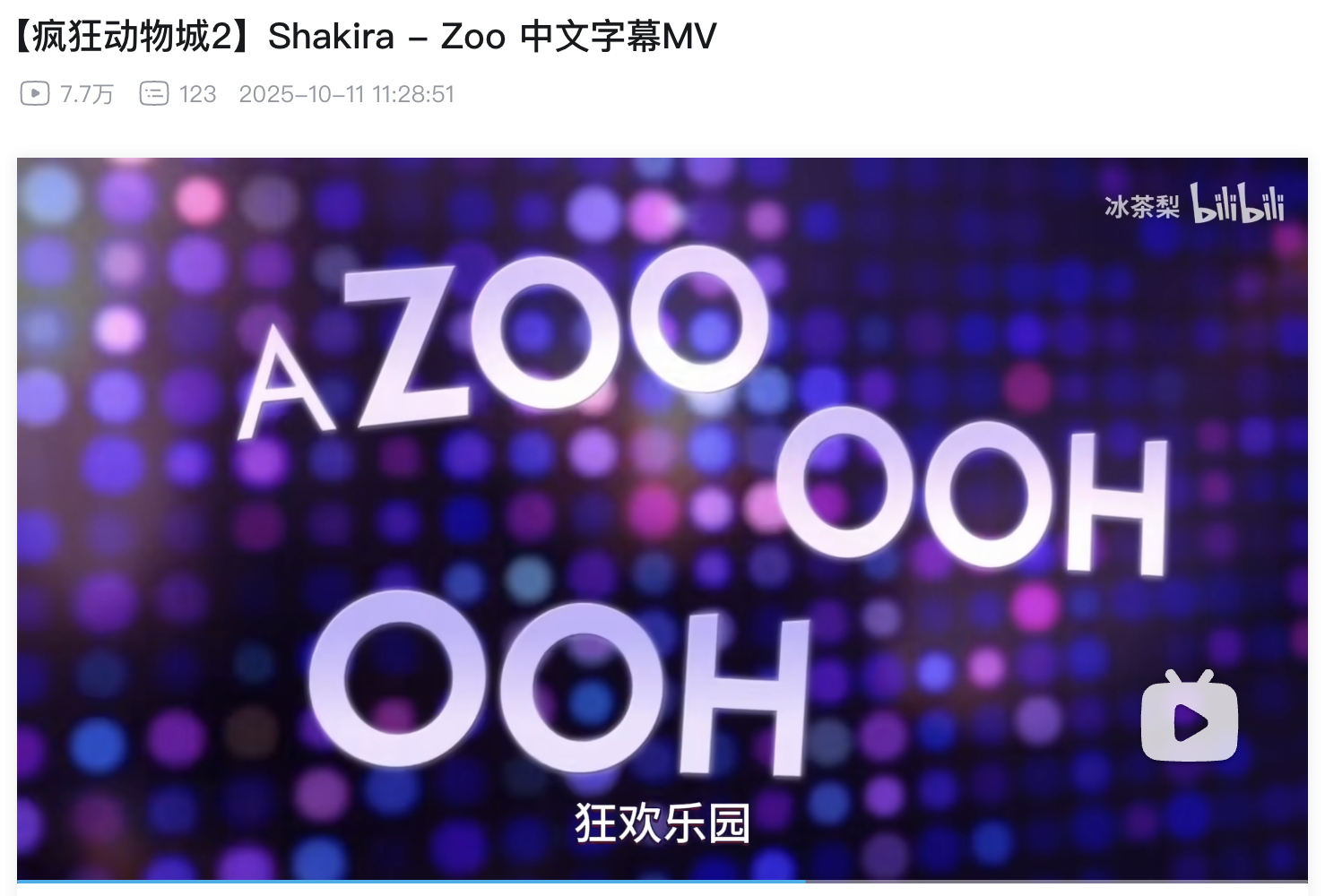
30
Nov 2025Zootopia 2 and “Zoo Ooh Ooh” in Chinese
I went to the movie theater with my family on Saturday to watch Zootopia 2 (疯狂动物城2) here in Shanghai. As usual, we watched the movie with the original audio and Chinese subtitles, and enjoyed it a lot. But I did take note of the subtitles here and there and noticed a little translation detail that I liked. It relates to the new Shakira song “Zoo” I’m including below:
The part I’m talking about is where Shakira sings “zoo ooh ooh.” As song lyrics it’s slightly clunky, because the Chinese word for “zoo” is 动物园 (dòngwùyuán), which doesn’t rhyme with “ooh.” Not a huge deal, obviously, but the translators realized they could do better.
So they rewrote the song lyrics a little bit so that where the English lyrics are “zoo,” the Chinese lyrics are 动物 (dòngwù), which actually does rhyme with “ooh”. In this onscreen translation, the “ooh ooh” was also “translated” (transliterated) as 呜 呜 (wū wū). Nice!
I went to YouTube and then Bilibili to try to find a video with this translation, but I actually couldn’t find it. Instead I found this literal translation of “zoo” (to 狂欢乐园 and 狂欢动物园):
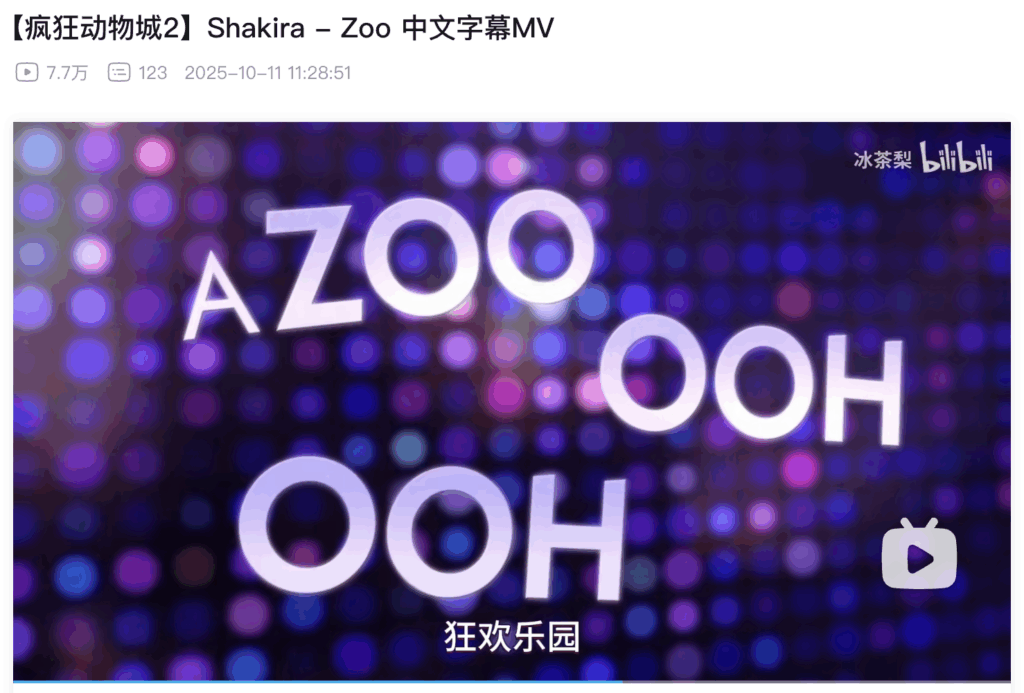
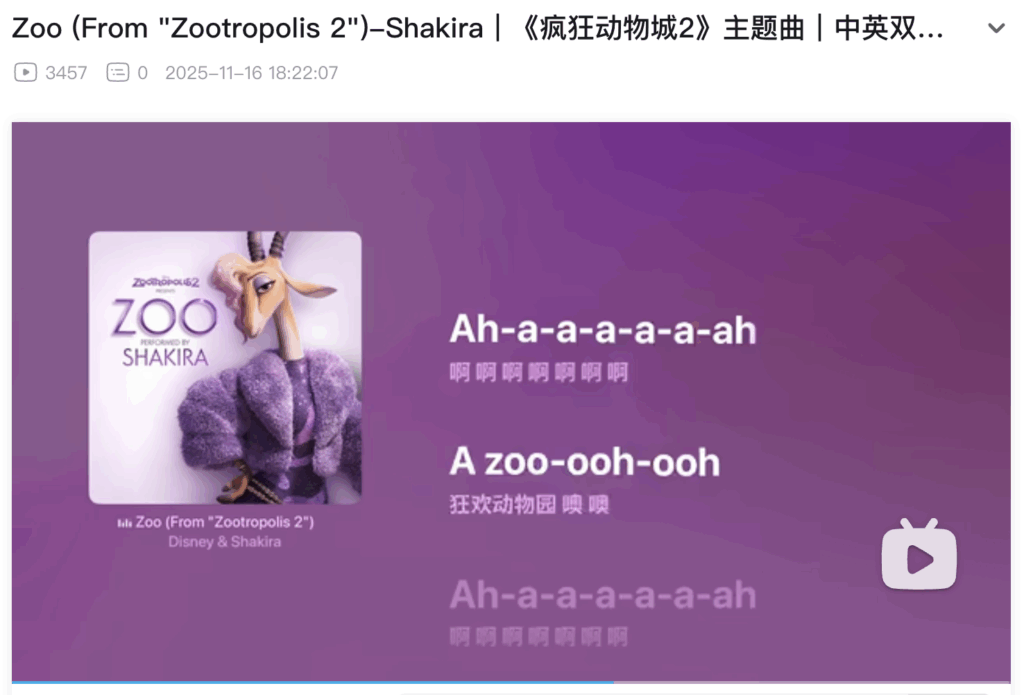
Let me know if you find the better translation somewhere. I haven’t heard a Chinese version of the theme song yet, but I’ll be interested to see what translation they use (hopefully the one I saw in the theater subtitles).
20
Aug 202525 Years!
I just had my 25th Chinaversary today. Although I don’t usually pay much attention to this date, 25 years felt like enough of a milestone to make a cheesy graphic about it!

(Yes, apparently I’m big in Guilin.)
So the amount of time I’ve lived in China has now significantly exceeded the amount of time I’ve lived in the US or anywhere else.
It’s a weird feeling.
I’ve written about my history with Chinese over on the ARC (Advanced Readings in Chinese) Substack if anyone is interested in taking a peek.
02
Jun 2025The Periodic Table in Chinese has fun surprises
I recently came across this YouTube video, and it echoed a lot of the same discoveries I made, back in the day. If you’re learning Chinese, and you’re even a little bit curious about the names of the elements in Chinese (and yes, this involves some special characters!), check it out:
A got AI to provide a nice little summary of what the video covers:
- Unique Characters: Unlike the Japanese system which largely uses phonetic borrowings, each element in Chinese has its own distinct character, which is unusual as most Chinese words are compounds of multiple characters [01:33].
- Rarely Used Characters: Many of these element-specific characters are very rare, and the discovery of new elements presents opportunities to coin new Chinese characters [01:54, 02:08].
- Phonsemantic Compounds: Almost all characters on the Chinese periodic table belong to the category of phonsemantic compounds [05:22, 06:29]. These characters combine a semantic radical, which hints at the element’s general category, and a phonetic element, which suggests its pronunciation [05:22, 05:52].
- Radical Categories: The semantic radicals used for elements are often based on their state at room temperature: the metal radical for solid metals, the stone radical for solid non-metals, the air radical for gases, and the water radical for liquids [06:56].
- Phonetic Elements: The phonetic component of the character is usually a simplified transliteration of the element’s international name (often English or Latin) [07:35]. However, some common elements have native Chinese names [07:52].
- Conjoined Meaning Elements: About ten elements also belong to the conjoined meaning category, where the character combines elements with related meanings, such as oxygen including the character for nourishment [06:38, 08:16]. These are also phonsemantic [08:41].
- Naming New Elements: Naming new elements involves assigning a radical based on predicted physical properties and a phonetic element based on the international name. Homophones with existing element names need to be avoided [08:49, 09:36].
- Pronunciation: Generally, the pronunciation of these modern element characters closely follows their phonetic components, even in tone, as sound changes haven’t significantly altered them yet [09:55, 10:03].
- Homophone Issues: While there are generally no homophones among element names, tin and selenium are both pronounced “C,” leading to an alternative reading for tin [10:17, 10:27].
- Lack of Disambiguation Suffix: Surprisingly, the suffix “su,” commonly used for disambiguation in Chinese, especially for monosyllabic words, is not typically used with element names [10:41, 11:05]. The speaker finds the Chinese system of naming elements to be interesting and well-designed, despite being a non-expert in chemistry [11:35].
14
Jan 2025Feminine Product Euphemisms in Chinese
I saw this posted by David Moser on Facebook recently:
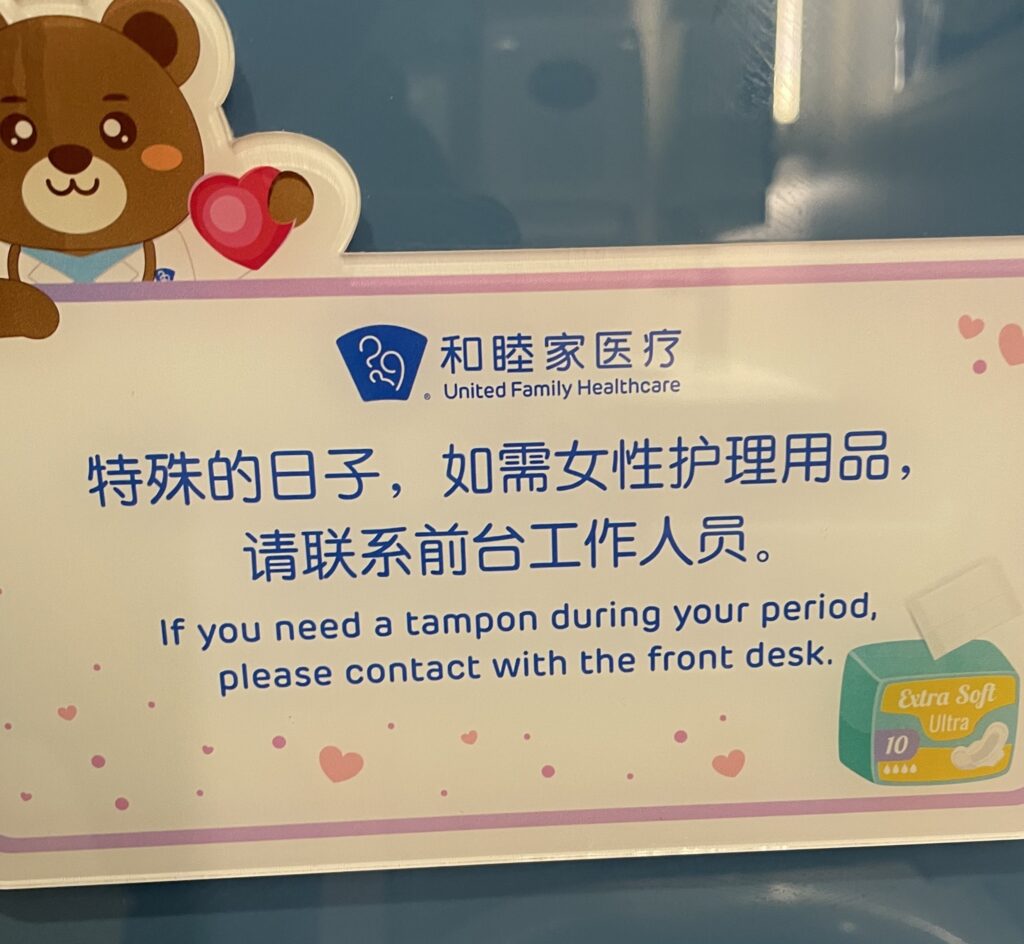
David writes:
This bilingual sign in the restroom of a Beijing hospital is interesting. The Chinese literally reads: “[If this is] a special day, [if] you need a feminine hygiene product, please contact someone at the front desk.” The English eschews such gentle euphemisms: “If you need a tampon during your period, please contact with the front desk [sic].” An interesting cultural difference?
Note that the translation of “tampon” in the sign isn’t quite accurate, and the picture doesn’t match.
There are definitely a lot of Chinese euphemisms regarding the topic of menstruation. The one I hear the most is also the simplest: 我老朋友来了 (wǒ lǎopéngyou lái le), literally, “my old friend is here.”
30
Dec 2024Children’s Charity Bazaar
Some friends in Shanghai are organizing this:
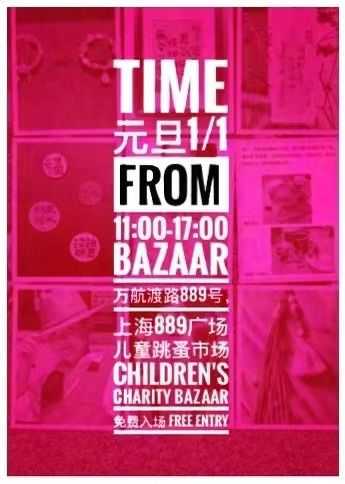
If you’re in Shanghai this January 1st (2025), come to the Children’s Charity Bazaar, which benefits the Heart to Heart Foundation, helping underprivileged children get the heart surgery they desperately need. You don’t even have to wake up early! 11am until 5pm at the 889 mall (889 Wanhangdu Rd.).
Some more info about Heart to Heart from its website:
Heart to Heart is a special fund of Ren De Foundation. We are Shanghai based, but provide corrective surgery for Chinese children from all over China with congenital heart disease (CHD) whose parents are unable to afford the surgery. To date H2H has sponsored over 3,410 children for heart surgery. The surgeries not only saved their lives, but transformed the lives of their families.
Heart to Heart is proud of the fact that we are and always have been a 100% volunteer organization. We have no paid employees. We also have a $0 operating budget which means that 100% of donations are spent for surgeries. Sponsors are given documentation on where their donations were spent and can also visit the children while the children are in the hospital for their surgery. Sponsoring a child is a truly moving experience.
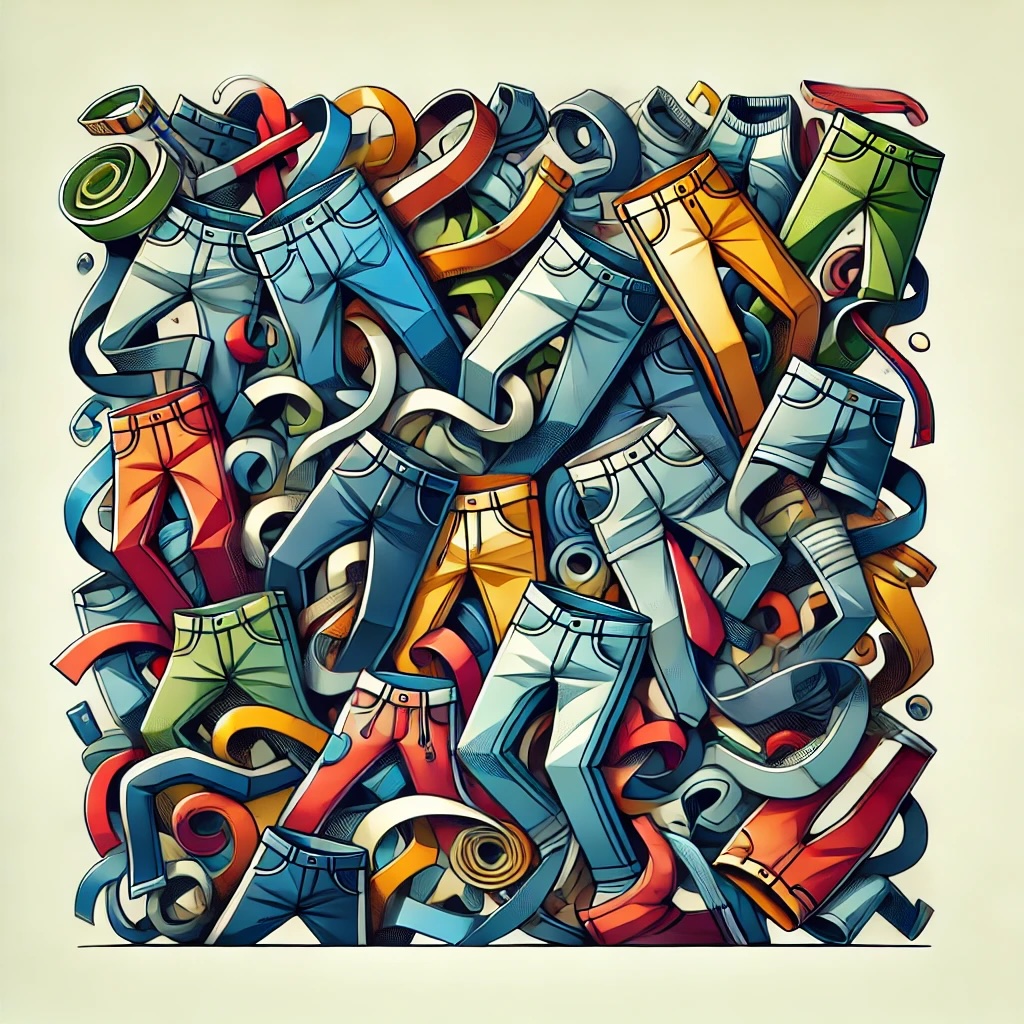
26
Oct 2024More Pants than Pant
So I had a great time on my trip to Naples, Italy (I’ll have to write more about that soon), and after returning to Shanghai I have continued to study Italian through Duolingo and ChatGPT.
One thing that I’ve noticed about Italian is that plural forms require a lot more attention than I’ve ever given them in any of my language study to date. In Spanish plurals take an “s” like in English. Then in Japanese and Chinese, you don’t have a regular plural form, for the most part.
Suddenly in Italian you have “-o” and “-a” turning to “-i” and “-e” and no “s” in sight! So it requires more attention, but it’s interesting.
Meanwhile, studying Italian also brought to my attention another issue that Japanese and Chinese never did: how the word “pants” (e.g. “trousers” for you Brits) is plural. Why is it plural? It’s one piece of clothing like a shirt or a dress. Sure, there are two pant legs in a pair of pants, but there are also two sleeves in a shirt. Italian uses a plural word for “pants” just like English and Spanish.

This got me thinking… what about other languages in Europe? So my buddy ChatGPT helped me create this chart, which seems to be accurate:
| Language | Word | Singular/Plural |
|---|---|---|
| English | pants | Plural |
| Spanish | pantalones | Plural |
| French | pantalon | Singular |
| Italian | pantaloni | Plural |
| German | Hose | Singular |
| Dutch | broek | Singular |
| Portuguese | calças | Plural |
| Russian | брюки (bryuki) | Plural |
| Greek | παντελόνι (panteloni) | Singular |
| Polish | spodnie | Plural |
| Swedish | byxor | Plural |
| Norwegian | bukser | Plural |
| Danish | bukser | Plural |
| Finnish | housut | Plural |
| Hungarian | nadrág | Singular |
| Czech | kalhoty | Plural |
| Slovak | nohavice | Plural |
| Romanian | pantaloni | Plural |
| Bulgarian | панталони (pantaloni) | Plural |
| Croatian | hlače | Plural |
| Serbian | панталоне (pantalone) | Plural |
| Estonian | püksid | Plural |
| Latvian | bikses | Plural |
| Lithuanian | kelnės | Plural |
So, only French, German, Dutch, Greek, and Hungarian have a singular take on “pants.” Interesting…
05
Oct 2024Business Trip to Naples, Italy
I’ve got a trip coming up this October 6-12, and it’s to Naples, Italy. I’m quite excited about it because I’ve never been to Italy.

The trip is a meeting with some European academics working on a multilingual, international platform for teaching Chinese. I’ve been contributing to the project through the Chinese Grammar Wiki, and this month I’ll finally be able to meet up with the other academics (from Poland, Denmark, the Czech Republic, Italy, and Germany) and discuss grammar pedagogy and resources. (I’m pretty sure AI is going to come up as well.)
It’s funny, about 16 years ago I was managing a number of “LanguagePod” teams while working at ChinesePod. One of them was ItalianPod, and while I loved that team and the energy and culture they brought to the company, I never really learned much Italian. “Ciao a tutti!” comes to mind.
Now, knowing for a while that I have this trip to Italy coming up, I’ve been studying Italian on Duolingo and using ChatGPT to tutor me in Italian with reference to Spanish (which I have still retained quite a bit of). I’ve been building my own phrasebook and using AI to create audio for that phrasebook. It’s all been a very fun and interesting way of learning Italian quite different from ItalianPod (which, unfortunately, is not so easy to find now). We’ll see how it goes…
If I have any friends in Napoli I’m not aware of, please get in touch!
04
Oct 2024This BBQ is FIRE

The fire component 火 has been enhanced on this sign, quite appropriately, since the word is 烧烤 (shāokǎo), or “barbecue.”
Taken on a mountain road near Tonglu, Zhejiang Province (浙江省桐庐县).
(PSSST…. If you’re looking to finally learn to read Chinese characters, by sure to check out my new book!)
08
Sep 2024Reflections on my Experience Learning to Write Chinese Characters
I recently contributed the following reflection to a book called Transforming Hanzi Pedagogy in the Digital Age: Theory, Research, and Practice: 电写时代的汉字教学: 理论与实践 (1st Edition) by Chengzhi Chu (Editor), Matthew D. Coss (Editor), Phyllis N. Zhang (Editor).
With permission from the authors, I’d like to share my contribution to the book.
Reflections on Writing Chinese Characters In and Beyond School
by John Pasden
Writing as a Beginner
As a beginner learner of Chinese at the age of 20, I was extremely enthusiastic about learning Chinese characters. It was the artistic, cryptic of the Hanzi that pulled me in from the start, well before I was sure if I could ever possibly even make myself understood in spoken Chinese.
I loved the (rarely guessable) pictographic representations, the even more unintuitive characters indicating abstract meaning, and the plethora of combinations in a myriad of possible structures that very nearly descended into madness.
Of course I was eventually able to make sense of the system, but that would take years. If not for the undeniable allure of the written form, though, I never would have made it to that point.
Captivated by Calligraphy
As an undergraduate student at the University of Florida, I had a language partner from Zhuji (诸暨) in Zhejiang Province, China. This guy was a brilliant engineer, but was also a kung fu practitioner, competitive at the national level. When I asked him to write some characters for me one day during one of our conversation sessions, I never imagined what I was in for.
The strokes flew from his simple ballpoint pen like water… streams, rivulets, and splashes dancing across the page. He didn’t even tell me at the time, but he was also proficient in pen calligraphy. It blew my mind that these beautiful strokes were actually written language.
My passion for Chinese characters was ignited, but at the same time some seeds of doubt had been planted: there was no way I could ever write like that, right? What am I even doing?
Writing in Daily Life
A year later I wound up living in China. The year was 2000, and I soon came to understand that the average Chinese person does not write like a wizened philosopher-calligrapher.
Although I was writing out Chinese characters in my notebook, writing flashcards, and filling out the occasional form as part of daily life in Hangzhou, hand-writing characters was not a huge part of my life in China. Listening, speaking, and reading were my main interactions with the language.
What I found myself doing more was using a relatively new (at the time) chat program called QQ. I could chat in Chinese with random strangers, and because it was all in text and I used a Chinese name, they didn’t even realize they were chatting with a foreigner until I gave myself away. I made a game out of trying to delay the reveal as long as possible. If I could just get my grammar and vocabulary right (and you know I was furiously looking up words during every chat session), then I could sometimes do it.
Although Chinese characters had a special place in my heart, removing hand-writing from my practice of the language was actually liberating and heartening because I could spend more time on what I loved about the language.
Hand-writing for Academia
A few years later, I was working hard to get into a Master’s program in applied linguistics at East China Normal University (华东师范大学) in Shanghai. Although I had a background in linguistics, it wasn’t in Chinese linguistics, and it wasn’t in Chinese. So I had to pass a test on modern Chinese. The stuff I would have learned if I had done my undergraduate degree in China. But perhaps most significantly, the test was composed of a series of essays, to be written by hand, with a time limit.
Working my way through the Xiandai Hanyu undergraduate textbook was not bad at all. I enjoyed it. But I had to be able to answer a variety of questions in essay form. My characters couldn’t look too awkward, and my writing needed to at least approach the level of a Chinese university student. Perhaps what challenged me the most was increasing my speed. The muscle memory needed to be formed. It was a huge challenge, and I often found myself frustrated that I couldn’t spend more time on the fascinating linguistic features of Mandarin Chinese. I was jealous of my classmates, who could effortlessly produce eloquent sentences in beautiful semi-cursive script. I knew my academic Chinese was improving rapidly, but when I watched them write, I felt pangs of despair. I had to repeatedly remind myself what I already knew: that hand-writing was not crucial to my learning.
The Death of Hand-writing (for Me)
I got into the Master’s program. Eager to learn and to prove myself as the only foreign student in my class, I was ready every lesson to take notes on my professors’ lectures. There were a lot of lectures. They were long. They were sometimes rambling. Before long, I started wondering how many notes I really needed to take. And I noticed that some of my classmates were bringing their laptops to class.
By the second semester, I was digital only. It was so much easier to type out any notes I needed to take. More importantly, after being admitted into the Master’s program, I never needed to write by hand again. In the work I started doing in my field, I never needed to write by hand either. This was a trend that would extend to all aspects of my life in China.
What’s more, I had proved to myself that I could do it: I could get my hand-writing speed and proficiency to the point that I could pass written exams. But I would probably never again take such a written exam. Knowing I could do it was enough for me. The challenge had been met, and I was ready to move on.
Breaking the Cycle?
I’m now an educator helping learners of all levels to learn Chinese. The subject of characters and hand-writing comes up often. Usually the solution is simple: in this day and age, it’s no longer necessary to learn to write everything by hand. Sure, there are exceptions… if you want to become a Chinese calligrapher, your fate is quite different! But most learners nowadays want to read electronic texts in Chinese and send messages to Chinese friends on WeChat, by email, or in other digital spaces.
And yet, some learners have trouble remembering characters at all without considerable time invested differentiating similar characters, researching character etymologies, or, in some cases, even writing out lots of characters like the students of yesteryear.
Furthermore, my own children have grown up in China, and I see no sign of the rote method for learning characters changing any time soon. Even in the midst of the Shanghai government’s “Double Reduction” (双减) policy, and the online schooling forced upon us by the pandemic, the demand for extensive hand-writing continues.
I can’t help but wonder: can we learners ever be truly free of this burden when native speakers are not? Is a better solution already here in this digital age if we could just shake off the shackles of tradition? Although the temptation is strong to teach beginner foreign learners in the same rote ways that Chinese children have learned traditionally, new research is promising. Personally, I am optimistic.
Additional Links
- If you are an educator or learner interested in this book, you can purchase it on Amazon: Transforming Hanzi Pedagogy in the Digital Age: Theory, Research, and Practice: 电写时代的汉字教学: 理论与实践 (1st Edition). I truly believe that this is the future of Chinese learning, and it’s great to see this group of educators pushing forward with the idea of typing as primary over hand-writing character.
- Olle Linge, writer of the blog Hacking Chinese, was another contributor to this book. He has posted his own contribution here: Chinese character learning for all students.
- This summer at AllSet Learning my team and I have finally made public a very long-term project in the form of a book called Learn Chinese Characters by Reading. It provides a method and a sequence for learning to read the 200 essential characters which will put you on the road to reading Chinese. It is very much in the spirit of the book I’ve quoted from above, and one of the researchers, Matt Coss, has written the foreword which you can read online. (I’ll be writing more about this book soon.)
08
Apr 2024Zheeeeeen Leeeeei
I found this fun shirt on Taobao:

I love characterplay but I found this shirt, while clever, a little whiny. So I checked the seller for other designs like this, but this was basically the only one of this kind.
02
Apr 2024Standing Escalator Etiquette in Japan
I always liked how people in Japan stood on one side of the escalators and let those in a hurry clomp on up or down the other side. It seemed courteous and efficient. At some point, years ago (maybe around 2010?), Shanghai also implemented such a system. Signs went up. I was told that Shanghai was adopting Hong Kong’s escalator etiquette. In any case, I saw it as progress.
Sadly, it didn’t last long. The system was abandoned after less than a year, as I recall. I never knew why.
On my last trip to Japan (March 2024), I discovered that Kyoto and Osaka are now discouraging the “stand on one side, walk on the other” escalator system. I was quite surprised by this.

I did a little research and discovered two things:
- There are a lot of old people in Japan taking the subway system. Having a “fast lane” on the escalators is seen as a safety risk. (Fair enough.)
- A study has been done which showed that the “fast lane” escalator system actually results in a lower throughput over the same amount of time. (The key is that only about 25% of escalator commuters use the “fast lane,” but it takes up half the escalator.)
So I guess this is a triumph of reason and science?
I still kind of miss the fast lane, though. In Japan and in Shanghai.
01
Feb 2024Sleep No More in Shanghai
Last Friday I went to a production of Sleep No More (不眠之夜) here in Shanghai. My wife bought us tickets. Although she has a pretty good record of choosing this kind of live entertainment, for some reason I was expecting something boring. Sleep No More is definitely not boring.
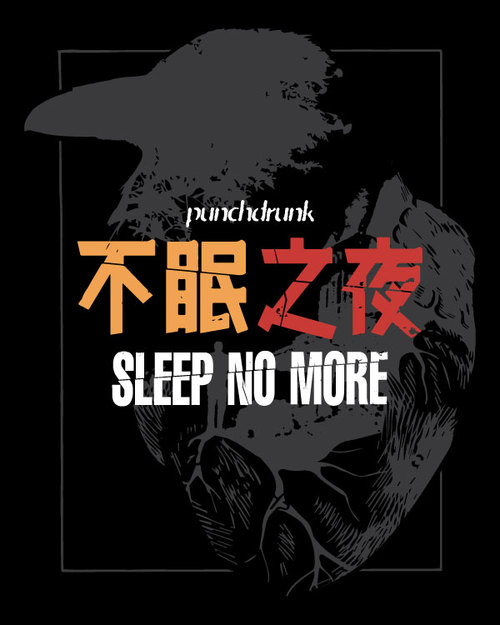
In this immersive theatre experience, the audience disperses and wonders through sets covering 5 floors while the cast act out various scenes across all 5 floors. There is no dialog and there is no way to see everything. You have to choose which characters to follow, where to go, and hope for a little luck. Going with friends really helps, because you can split up and compare what you witnessed. The story actually repeats as a loop, three times over three hours.
The whole thing feels like a dream, and the sound design enhances this. Plus every member of the audience is required to wear a white mask. This turned out to be really crucial, because it helps everyone to identify the characters in the story you’re trying to watch. It’s also a clever trick by which a member of the cast or the staff can easily disguise himself as an audience member, and the characters in the story do occasionally interact with the audience a little bit.

At one point, one of the female characters was doing a sexy dance in an old style telephone booth (the story is set in the 1930’s). The woman pulled in a member of the audience, then closed a curtain. Later on when she opened the curtain and left the booth, the audience member was gone. I investigated and found a secret door in the back of the booth. I was going to go in, but the staff pulled me away. Although the production encourages the audience to “be bold,” there are definitely places you’re not allowed to go.
Anyway, this was a very interesting theatre experience, the kind that really sticks with you. It’s not cheap (around $100 USD), but entirely worth the price. There’s not even any appreciable language barrier, given that the story is told without dialog. So if you’re in Shanghai and looking for an interesting cultural experience, this one is worth a try. (Not for kids. You will need to reserve tickets in advance.)
21
Nov 2023Thoughts on Yangshuo (Guangxi)
The first week of October is still China’s “National Day Golden Week” holiday, meaning that we get 7 consecutive days of vacation October 1-7. Of course, such a treat can’t come without a bit of pain… in this case, we also had to work the weekend after to “make up for” some of the days off. Truly a maddening system. A seven-day workweek following the holiday really does come close to nullifying the whole point of the holiday for many.
For the October holiday this year, I went on a trip with my family to Yangshuo (阳朔), a mountainous region near Guilin full of all kinds of outdoor activities. Actually, though, we didn’t really go to Yangshuo. That’s kind of the point of this post.
I first went to Yangshuo in 2003 as a teacher still living in Hangzhou. It was just becoming a popular tourist destination back then because many other choices, such as nearby Guilin, had already become way too touristy. Anyone looking for something more outdoorsy, a bit off the beaten track, had to seek out less well-known locales. At the time, Yangshuo fit the bill perfectly.
The next time I would visit Yangshuo was in 2022. My wife knew about the destination from me, and had heard good things about it. She found a local tour company that could set up family-friendly activities like swimming, hiking, caving, stand-up paddle boarding, and river trekking. What I didn’t initially know at the time was the activities planning were almost entirely not in Yangshuo, but the neighboring area. This is because in almost 20 years of development, Yangshuo had become so touristy as to be generally avoided by many travelers.
So this past trip I paid more attention. We didn’t actually go to Yangshuo at all (except maybe passing through). We spent most of our time in a county called Xingping (兴坪). It was all pretty fun, and despite the hordes of holiday tourists, we were generally able to avoid them and do our own thing.
Some photos:







30
Sep 2023HACKED
Hello to my email subscribers (if you’re still there).
I’ve been hacked in a way that is only visible to my email subscribers. Spam messages are going out through WordPress.com email notifications.
I’m working on fixing it, but unfortunately this happened right when I went on vacation to Yangshuo with my family. Will try to solve it ASAP!
UPDATE: I had the problem fixed within 24 hours, but unfortunately some of you got spammy emails from Sinosplice. Sorry about that. The problem is fixed.
17
Aug 2023Chinese-like Graffiti in Atlanta
My original hometown may be Tampa, Florida, but my family relocated from there to Atlanta, Georgia in 2020. So this past July, I was finally able to take my whole China-based family to visit this new “home base” in the US. It was great to be back with family for almost a whole month after being unable to visit due to COVID for about 4 years.
I won’t say too much about the visit, other than that it was really nice. I’ve been taking a break from blogging this year, and we all had a great time.
Chinese did randomly intrude on our vacation, though, such as in this graffiti I spotted on the Atlanta Beltway.

Here’s a closeup of the part on the right:

Is this real Chinese? I’d have to say no. It does look like a “graffiti style font” of real characters in some ways, and I can recognize parts of real characters, but then they also have weird extra strokes that don’t work. There are a few “near misses,” but every single one looks off in some way.
Still, it’s fun to see this. You can tell that someone took the effort to really observe real Chinese characters and try to do their own artistic take on them.
And I do love a little characterplay!
28
May 2023Share Bikes, Stacked High
Years ago, I blogged about Mobike and how it was changing the way we commute in Shanghai. That’s old news now. COVID has come and gone (sort of). But we’re still using these shared bikes. Now there are two big names: Meituan (unlock the bikes by scanning their QR codes with WeChat) and Hello Bike (unlock the bikes by scanning their QR codes with AliPay).
These shared bikes are all over the city. Sometimes there are so many of them in one area that a sidewalk will be completely blocked. In order to redistribute the bikes in a useful way, you often see big trucks collecting the bikes from an area overflowing with them in order to send them somewhere they’re needed.
And then you might also see this:
(Videos courtesy of Issac L.)
05
Apr 2023Rate of Speech Affects Learning
I think rate of speech is one of those things that gets some attention at certain points in one’s studies (especially the beginning), but easily gets forgotten under mountains of vocabulary, tsunamis of pronunciation, and avalanches of grammar.
Here’s a You Can Learn Chinese podcast from last month where we discuss how rate of speech stays relevant at different stages of one’s studies:
- Teachers’ rate of speech (super important in the beginning)
- Dangers of not adapting to a natural rate of speech in one’s studies
- Looking for the right rate of speech for input
- Keeping goals in mind
- Using software to adjust rate of speech for listening materials
- Speaking faster vs. correct tones
- Perceived fluency gains with speaking more quickly?
03
Feb 2023Using ChatGPT to Learn Chinese
I got back from a family trip to Lijiang (Yunnan) last week. It was quite interesting being there again when my first and only trip to Lijiang happened a full 20 years ago! (Yeah, yeah… I’m old!)
I remember even then that some tourists were lamenting that Lijiang was “too commercialized.” Obviously it’s more commercialized now, but I still found it nice. One big difference is that while I used to see Naxi women in the “old town” of Lijiang wearing their traditional clothing selling food, clothing, and trinkets, I no longer do. Instead, it’s lots of tourists (mostly young women) decked out in rented Naxi garb (or even Tibetan) in order to take photos.
But anyway, I’m back in Shanghai now, and one of the reasons I’m happy to be back is that I can continue to experiment with ChatGPT every day. It’s super addictive and fun, and it also has great potential for Chinese learning. So I thought I’d share a few things I’ve discovered. I’m planning to go into more specifics in an upcoming series on the AllSet Learning blog.
What Can Chat GPT do in Chinese?
Here’s a simple rundown of some of the many things you can do with ChatGPT, starting with the obvious and getting more specific:
- Translate between English and Chinese (or whatever other languages ChatGPT can handle)
- Adding pinyin to Chinese (it often does this by default for Chinese output when the prompt is in English)
- Provide both simplified and traditional characters, or convert between the two
- Create frequency lists of Chinese characters (limited)
- Creating lists of Chinese words
- Provide Chinese characters with pinyin for an article in English which mentions Chinese words.
- Generate short paragraphs in Chinese on any topic
- Generate short paragraphs of text in both English and Chinese (parallel texts)
- Respond in Chinese to chat prompts in Chinese
Sounds pretty cool, right? OK, but hold on… it doesn’t do any of these tasks perfectly. It does most of them well, though (especially general translation).
Here’s an example of me asking for the Chinese words (with pinyin) for English output about Lijiang it had just given me:
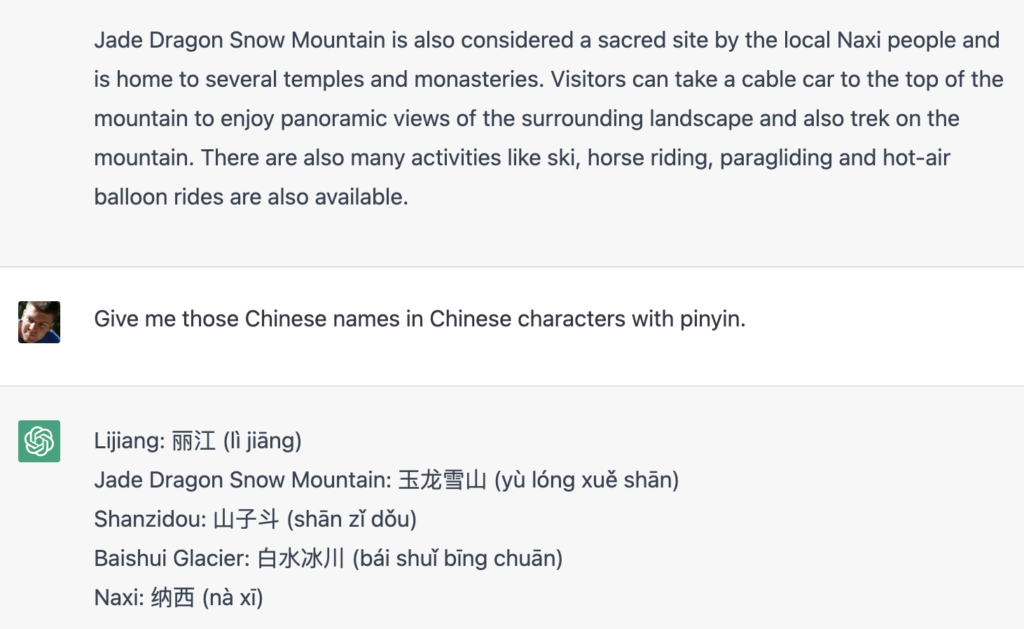
I had it generate a frequency list of Chinese characters using a custom format I wanted (with the slashes and parentheses), and also including Japanese. It did take a bit of back and forth to get the formatting right, but here’s the result:
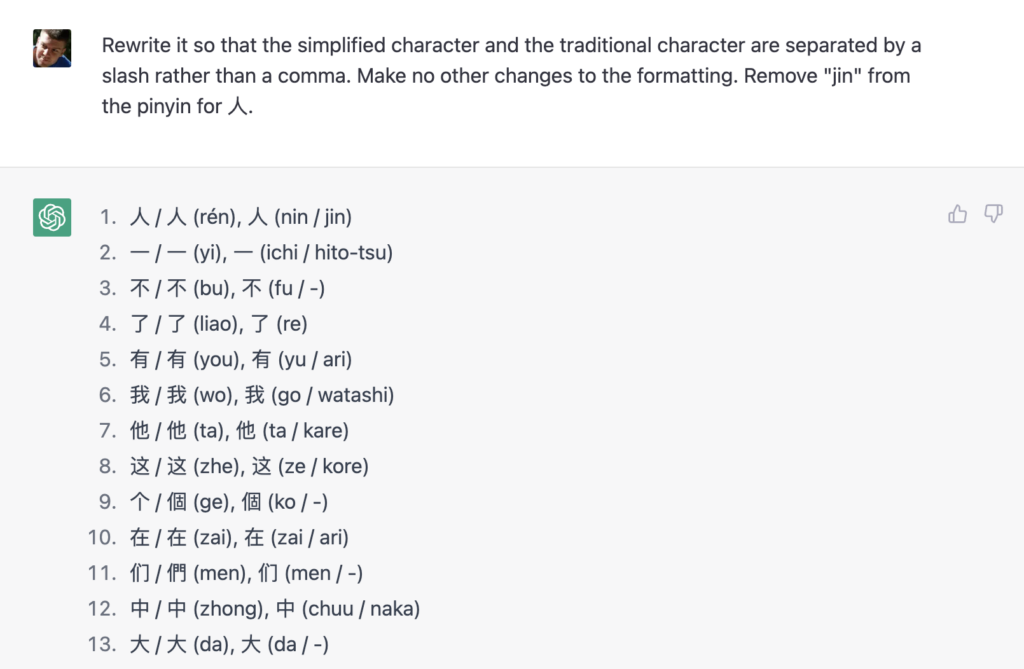
BUT, you may be surprised to learn that ChatGPT doesn’t have access to Chinese word frequency data, so word frequency lists will be trickier.
Let’s get into more specifics about some of the other problems.
Problems with Using ChatGPT for Chinese
OK, first of all, the obvious: it sometimes just plain gets stuff wrong. You can correct it, and it will readily admit and correct its mistake, but you might not realize the mistake is there at all.
Here’s a simple pinyin mistake I called it out on:

Another annoying thing is that, by default, pinyin is not grouped by words (it’s not word segmented). You can get ChatGPT to segment by words, but it’s harder than you might expect. It took me quite a few tries, and in the end, I had to manually segment the pinyin of the first sentence for it and provide that as a model. After that, ChatGPT was able to do the word segmentation (more or less) correctly.
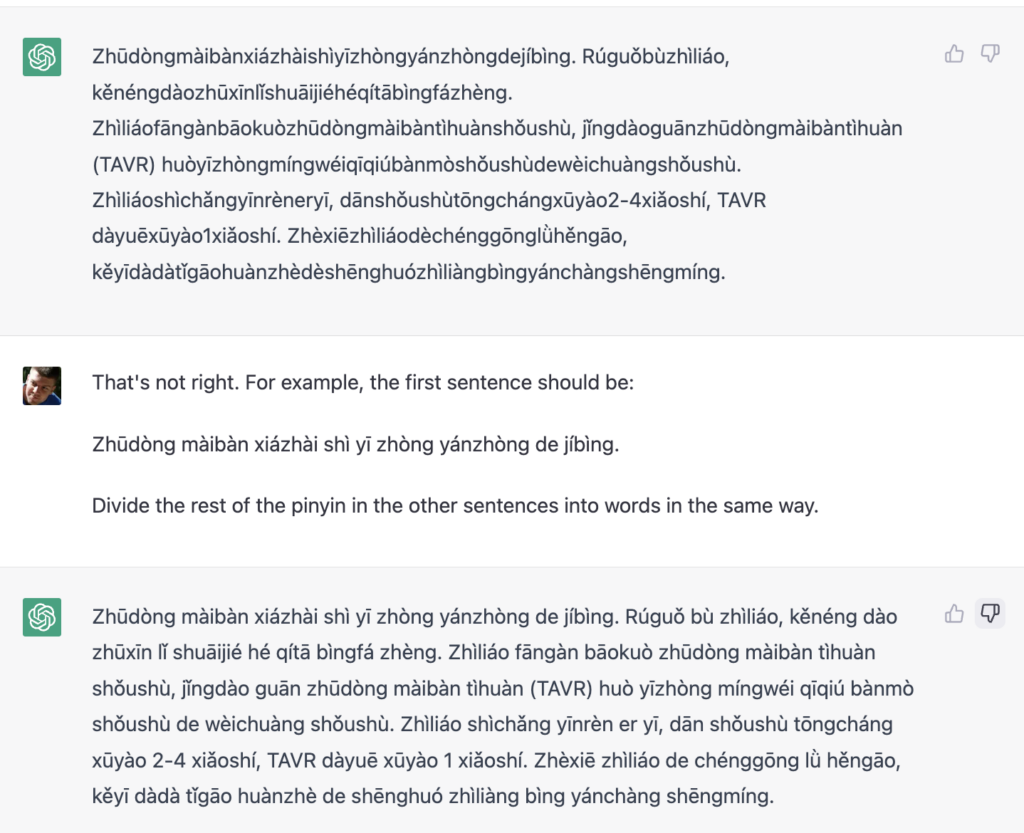
It can also easily make factual errors about stuff related to Chinese. It looks more “correct” when it’s accompanied by pinyin, but it still might be just plan wrong!
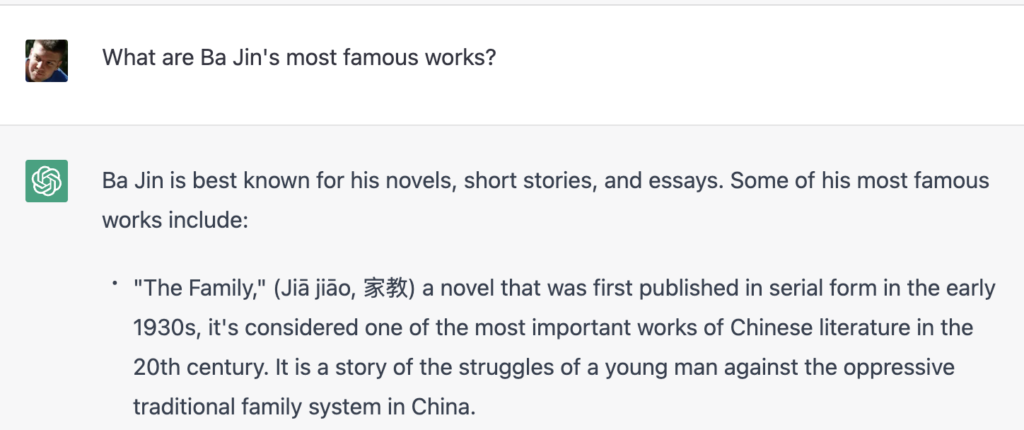
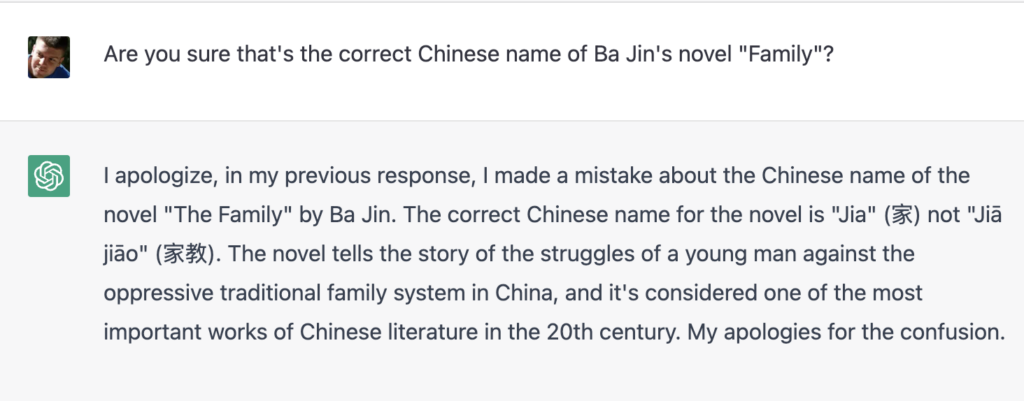
Sometimes it uses the wrong punctuation for Chinese (maybe because I was mixing the languages in my prompts). You can ask it to fix that, but it’s still annoying.
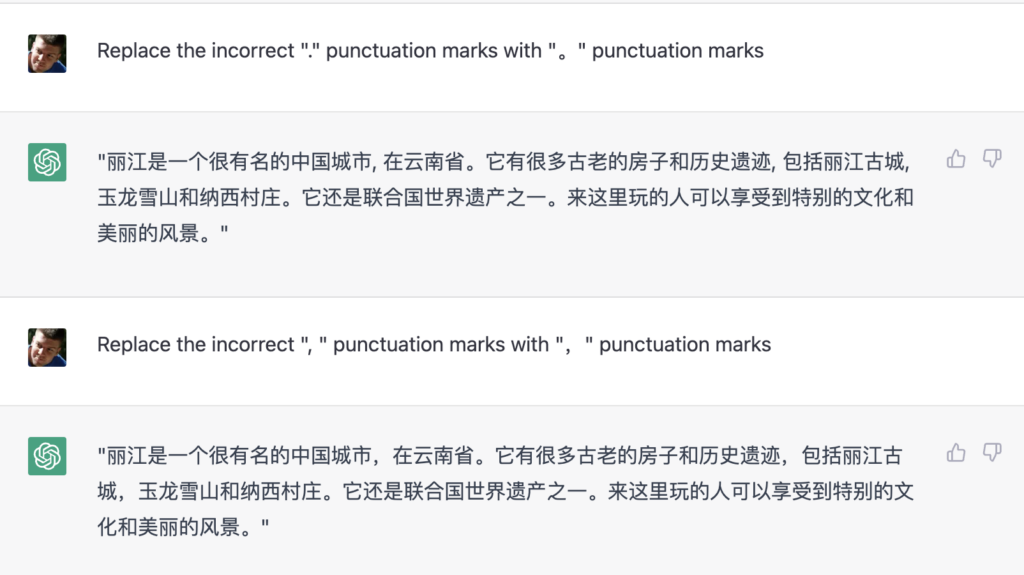
How about simplifying? You might have high hopes for this, considering that ChatGPT is quite good at simplifying English explanations. It can do it in Chinese, too, but often not well. It does not seem to have a sense of what is “difficult” for learners. I imagine this is largely result of an absence of such material for the AI’s training, but the result is very real. ChatGPT is not good at writing very simple texts for learners.
Here’s an example of me trying to get it to simplify text as far as possible:
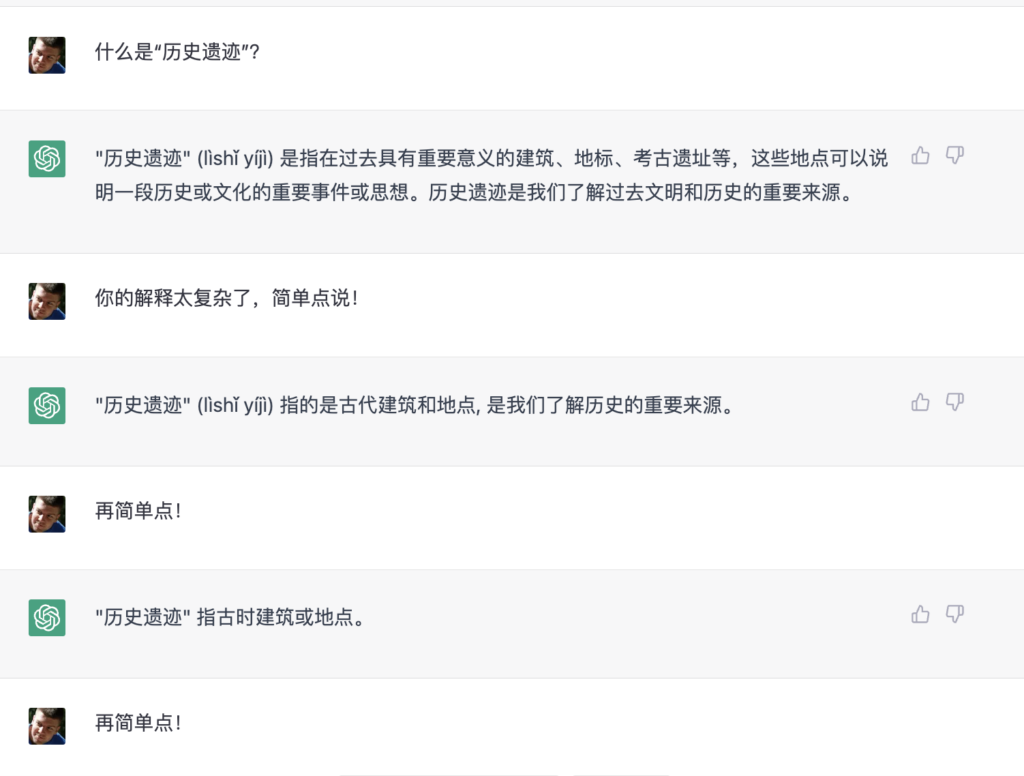
This went on for a bit longer, and the end result was:
“历史遗迹” 是古代建筑或地方。
I’m sure ChatGPT will get better at a lot of this stuff, but likely not before ChatGPT becomes a paid service. (There’s plenty of room int he market for specialized AI products, though!)
What to Use ChatGPT for to Learn Chinese
So what should you use ChatGPT for as a learner?
- Learn about Chinese culture and get the vocabulary with it. I love being able to ask for the Chinese (with pinyin) when discussing any topic in English. This is something that annoys me when reading in-depth articles on topics related to China: they often don’t provide the Chinese at all (or maybe just pinyin with no tone marks).
- Chat in Chinese. Hey, it’s a chat bot, after all? It’s infinitely patient, can provide pinyin, can say things in different ways, etc. It might not always use simple Chinese, but there’s still loads of potential there.
- Generate short texts. If you’re intermediate (or close to it), you could try generating short texts on topics you’re interested in. You could try jokes or even short stories. I’ve found that in general, the fewer constraints you give ChatGPT on its output, the more natural that output will be. So while you may not be able to restrict a text to only the Chinese that a first grader would know, you can still ask for texts on simple topics.
Keep experimenting! This stuff is only the tip of the iceberg. This blog post is more of a “quick and dirty assessment” than a comprehensive review. If you’ve discovered some cool uses of ChatGPT related to learning Chinese, I would love to hear about it.
02
Jan 2023Post-COVID 2023
I stopped writing in late 2022 because I didn’t want to turn this blog into a big whine-fest about COVID, and as a result, in a time when COVID in China was impacting every single aspect of my life, I found myself with nothing to write about.
I’d get an idea to write about “little signs of hope” and all the ways that people in Shanghai were subverting rules and letting normalcy seep into our lives here, but then there would be some COVID resurgence and everything would go the other way, and the whole “I don’t see how we are ever going to break out of this endless cycle” mentality of despair would set in again.
Well, in mid-December soon after China reversed its “COVID zero” policy, my whole family got COVID. It was rough (way worse than “a cold”), but we got through it. The same is true for most people I know in Beijing and Shanghai. We’re finally moving on past COVID in China.
That means I can travel again in 2023. It means I can write about other things in 2023. It means my businesses can start to recover in 2023.
I have high hopes for 2023.

Anyway, Happy New Year, everyone!
31
Oct 2022Happy Halloween from Shanghai (2022)
Wow, I took a much longer break than I expected since my last post. I’ve had some thoughts that I’ve debated with myself about sharing. I’m just not sure how much value there is to making post after post about the COVID situation here in Shanghai, and quite frankly, I’m pretty sick of the topic myself. But it’s still not going away.
So instead, for now, I’ll talk about Halloween a bit (and the topic of COVID will inevitably butt into the conversation too, as it always does here).
Trick or Treating in Shanghai
Since having kids (my kids are now 7 and 10), I’ve been at somewhat of a loss for how to share American Halloween culture with my own kids. In Shanghai I have taken them to parties, to mall activities, to outdoor festivals… But in the past few years we’ve been invited to go trick or treating at the homes of friends that live in communities with houses (rather than apartments). These neighborhoods in Shanghai really kind of feel like American suburban neighborhoods. Then come Halloween time, the residents really go all out decorating and the streets are filled with trick or treating kids going door to door. Almost every house in the neighborhood participates too. It really took me back to my own childhood, and I was glad I could share that experience with my own kids.

Here’s where COVID comes in, though…
Although my kids loved trick or treating, they noticed that the candy this year is different. My daughter mentioned offhand that there are also fewer foreigners living in the neighborhood this year compared to last. So it’s just another one of those countless subtle changes brought about by COVID… So many foreigners have left due to COVID that the neighborhood now has significantly more Chinese residents. And although most of the Chinese residents are totally on board with the neighborhood Halloween celebration, they do buy different kinds of candy. (There is a lot less chocolate this year, much to my chagrin.)
Not a profound insight or a bitter rant; just a little example of how COVID continues to affect our lives in random unexpected ways. (And yeah, a lot of foreigners have left.)
But hey, look at all these flavors of 大白兔 (White Rabbit candy)!
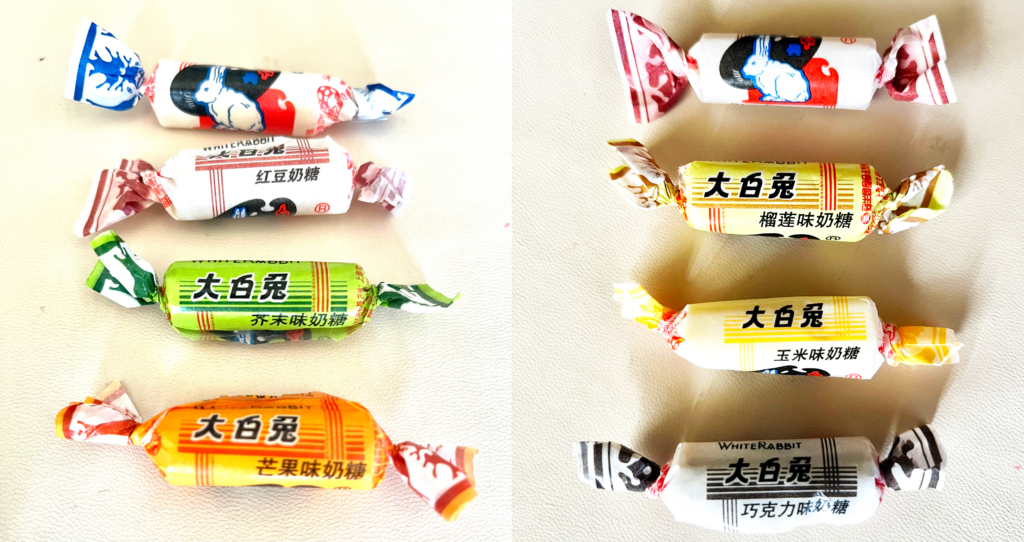
Happy Halloween!

